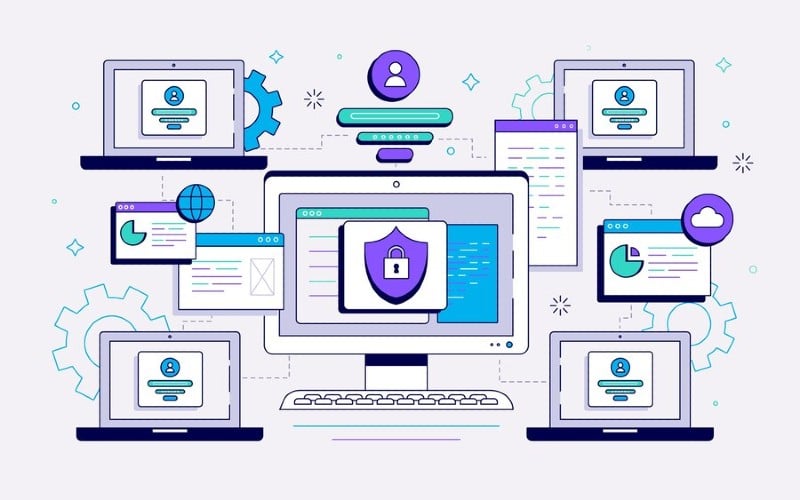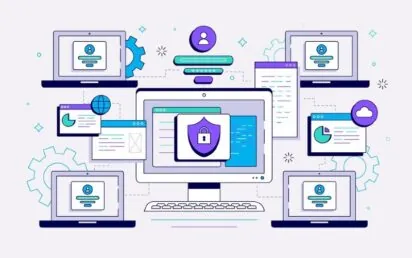Businesses of all sizes are severely threatened by cyber attacks. This can damage a company’s reputation and cause it to lose a lot of money in one single breach. Therefore, IT defenses are no longer optional but necessary.
Fortunately, around 98% of cyber occurrences can be prevented with basic cyber-healthy practices. Cyber hygiene is the practice of computer users to do routine actions and precautions to keep the system healthy and secure online. Like personal hygiene habits like brushing your teeth, developing healthy cyber hygiene involves developing favorable and consistent habits that reduce the likelihood of compromise.
Implementing solid cyber hygiene measures doesn’t have to be complicated or expensive for businesses. In fact, it’s often the simple, fundamental steps that go the furthest in protecting against threats. A secure infrastructure is the foundation of effective cyber hygiene, ensuring that systems, networks, and data remain protected against evolving cyber risks.
Understanding the Impact of Poor Cyber Hygiene
Before digging into solutions, it’s important to understand why strong cyber hygiene measures matter in the first place. Consider these statistics with the 2024 Data Breach Investigations Report:
- 14% of breaches involved the exploitation of vulnerabilities as an initial access step, almost triple the amount from last year’s report.
- 68% of breaches involved a non-malicious human element, like a person falling victim to a social engineering attack or making an error.
- 62% of financially motivated incidents involved ransomware or extortion, with a median loss of $46,000 per breach.
- 15% of breaches involved a third party or supplier, such as software supply chains, hosting partner infrastructures or data custodians.
These numbers show how easy it is for a business to be an attack victim without good habits in place. One breach, even if one, is a giant hole, especially for smaller companies.
Rationalizing cyber hygiene can make a world of difference by implementing sound practices based on your business. Good cyber hygiene prevents incidents and makes it easier to handle if you do fail to some degree. Let’s explore what’s involved.
Fundamentals of Good Cyber Hygiene
Cyber hygiene encompasses the procedures and practices that reduce vulnerabilities in systems and networks. That includes vulnerability management, risk assessments, and user awareness training.
Here are five key principles behind strong cyber hygiene:
Understanding threats and risks. This means that you would be aware of the new cyber threats, and you can prepare defenses against them. Regular risk assessment of systems, networks and processes and identify vulnerable areas there.
Reducing the attack surface. A comprehensive solution to ensure that only necessary ports and services are open, decommission proper hardware and software, and secure the system is to minimize the number of points of entry the attackers can use to its initial advantages.
Improving visibility. Audit systems using logging, analytics tools, and access attempts and monitor them. Threat detection is enhanced by understanding normal vs abnormal behavior.
Establishing the right culture. Instead of being a risk, the training of staff to adopt secure practices makes them a line of defense. Promote cybersecurity awareness company-wide.
Implementing routine safeguards. Consistent barriers against threats such as software updates, backups, access controls, etc. Good habits are key.
Turning these principles into concrete policies and procedures tailored for your organization lays the technology foundation and cultivates the human behaviors needed for strong cyber hygiene.
12 Actionable Steps to Improve Cyber Hygiene
Transitioning those broad concepts into day-to-day practices may still seem daunting. That’s why it’s key to focus on developing specific, simple habits over time.
Here are 12 highly actionable steps businesses can start taking now to boost their cyber hygiene:
1. Enable multi-factor authentication (MFA). Phishing or stolen credentials are prevented by other factors like biometrics of one-time codes. MFA all administrative accounts, remote access methods, email, and cloud apps.
2. Install updates promptly. Hackers have openings to exploit known software vulnerabilities by patching delays. Make sure the set devices and servers will automatically install important security updates.
3. Use strong passwords. Brute force attacks are lengthy and complex enough to fail. Use a password manager to create and store passwords that ‘look’ like the above string but are actually 15+ characters long for all employees.
4. Secure endpoints. Have all company devices requiring antivirus software, firewalls… especially drive encryption to avoid malware infections and data theft. Keep software updated.
5. Back up data routinely. Both ransomware and hardware failures indicate an important point: backups. Back up critical data, systems and servers on a regular schedule. Store backups offline.
6. Establish access controls. Control who has access to systems and data by giving employees the minimum level of access to only those components required. Immediately disable ex-employee access upon departure.
7. Secure Wi-Fi networks. Routers and networks that are outdated are a huge risk. Modern office Wi-Fi standards, encryption, SSID hiding, MAC address filtering and strong passwords should isolate office Wi-Fi.
8. Install a VPN. Set up a tool for encrypting remote employee traffic, a virtual private network (VPN) solution. Public connections can be kept secure with VPNs.
9. Control physical access. On-site vulnerabilities like an unlocked computer or visible passwords give bad actors an opportunity to exploit. Institute office security policies for workspaces, devices, paperwork, and servers.
10. Secure email. Equip, train and empower staff to identify phishing attempts and to employ the powers of email security, including DMARC, DKIM, and SPF, to validate legitimate emails. Enable spam filtering.
11. Monitor activity. Get logs and inspect them to get to anomalies quickly. Look out for climbs in outbound transfers, login attempts, or connections from the unidentified location.
12. Develop an incident response plan. Establish the details of the policies and procedures to address risks related to potential security incidents such as ransomware and data breaches.
In effect, these 12 measures work as a set of critical layers of protection. Hacking is an ever-changing game: hackers become smarter all the time, but the majority are still exploiting fairly common mistakes like weak passwords, unpatched software or social engineering. The better a defense is set up, the stronger the cyber hygiene blocks those avenues.
Afterward, businesses monitor systems for abnormal activity and alert them of potential incidents early enough for them to trigger incident response plans before threats escalate or data is compromised.
Implementing Cyber Hygiene Best Practices
The truth, of course, is that reading about cyber hygiene best practices does not mean your business gets more secure automatically. These measures need to be implemented consistently over time, no matter what staff or technologies change.
Bringing it all together requires an ongoing commitment to:
1. Assessing risks. What systems and data matter most? What regulations apply? Regular audits allow you to spend limited resources on highest highest-priority risks.
2. Assigning ownership. Assign internal champions to own policies, control systems, monitor systems and respond to threats. Consider forming a cybersecurity committee.
3. Establishing policies. What documents should you have defining the mandatory cyber hygiene practices, such as password requirements, access controls, and protocols for suspicious emails?
4. Training routinely. Run phishing simulation tests and educate new hires on how secure they need to be to work at your company. Have refresh training for existing staff at least annually.
5. Monitoring compliance. Unfortunately, for staff, time is too slow a healer. They need to be established via technical controls and audits enforced over time to ensure adherence to established cyber hygiene standards.
6. Updating programs. Assess changes to see how review policies and controls will update accordingly.
A lot of this can be managed internally by small companies using the free cyber hygiene assessment tools from cybersecurity vendors or government groups. Partnering with a Managed Security Services Provider (MSSP) for larger or more highly regulated or compliant businesses brings in additional expertise and having an expert watch over these threats 24/7.
Regardless of your size or industry, what you need to do is engraft that culture of security awareness and make it something you do — i.e., something that is a habit — throughout your organization.
Conclusion
As more and more business functions start going online, cyber-attacks will increase only in the years to come. While there’s no amount of preparation that will make you invincible, not practicing cyber hygiene is an inevitable recipe for disaster.
Thankfully, the vast majority of incidents today can be prevented via basic precautions such as the use of solid passwords, keeping software up to date, securing networks, restricting access, employee training, etc.
By following these basic best practices, businesses construct consistent barriers that prevent the usual entry points of threats. Additional monitoring and response plans will then allow you to catch and address inevitable anomalies faster.
Cybersecurity will always be a complex, changing business. By disassembling in critical, executable habits, businesses are given the tools to substantially fortify defenses and build the proper tenaciousness to survive in our digital bubble.
The secret is to have the resources allocated to not only put in place strong cyber hygiene measures but also work to shape processes and culture that will support these routines over time.


